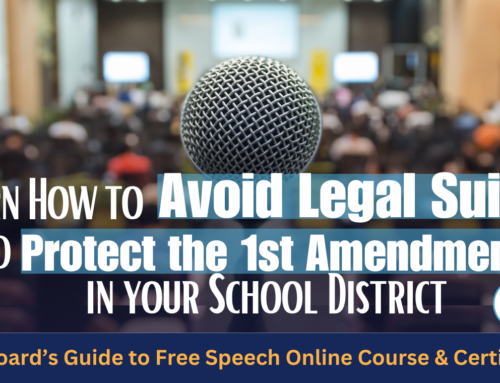
By: Elizabeth Canfield
I sat across the living room from an oil investor who traveled internationally on high-stakes negotiation trips. Though I knew little about those negotiations, I could still feel the palpable intensity of the situation he was describing. Words matter at the negotiating table, and he clearly knew what to say. With so much at stake, I wondered what it would be like to take on a role so significant, so dependent on verbal communication. Years later, as I came to know more about the art of negotiation, I realized that we all use the tug-of-war of debate to further our own agendas.
Former FBI hostage negotiator Chris Voss points out in his book “Never Split the Difference” that we negotiate as part of our daily lives. We negotiate to see the goals that we hope for become reality. For many, as it relates to government, we hope for policies that reflect our values and that further the promotion of a strong society. When we consider the form of public education, we hope for rules that stimulate the growth potential in our children consistent with our beliefs. But, as the world-renowned hostage negotiator points out, “Hope is not a strategy.”
If hope alone is not a strategy, then what is? Let me introduce you, my friend, to “Negotiated Rulemaking.”
Negotiated Rulemaking—The Practice and The Purpose
We know by now that negotiation is not just used by oil industry investors or FBI hostage negotiators alone. The federal government also employs a specific form of negotiation, called “Negotiated Rulemaking,” a process employed when government agencies are developing various kinds of public policy. Also known as ‘Neg-Reg,” this process was designed to bring people together to find working solutions to new policies. Too many policies stalled when met with lawsuits. By inviting interested parties to the negotiating table, the government hopes that problems can be hashed out in a constructive manner, producing workable solutions to policy disagreements.
One previous senior advisor for the U.S. Department of Education Department, Michael Brickman, notes that the process is successful by “allowing parties with competing interests the opportunity to negotiate and propose a reasonable outcome.”
How Negotiated Rulemaking Began
While this may seem like a common-sense approach to problem-solving, this method did not always exist. The practice began in 1982 when the disputes between policymakers and regulated parties grew mammoth. When the government handed down new rules, those affected by the regulations could only fight back one way — by taking it to the courts. Pursuing litigation was time-consuming, costly, and ineffective, and many felt their hands were tied behind their backs.
One government agency, known as the Administrative Council of the United States (ACUS), offered up a possible idea that became known as the method of Negotiated Rulemaking. A report from a division of the Library of Congress, the Congressional Research Service, outlines the process: “In negotiated rulemaking, an agency convenes a committee of stakeholders with the goal of reaching a consensus outcome on the text of a proposed rule. If the committee is able to reach a consensus outcome, thus achieving buy-in from stakeholders, the rule may be easier to implement and less likely to be subject to litigation.”
So how exactly does the process work? Here is a little behind-the-scenes. First, any agency that employs Negotiated Rulemaking must first release a public announcement posted on the Federal Register. The topics to be addressed, recommendations for members making up the negotiating committee and the final results of the Neg-Reg process are to all be shared on the Federal Registry. Once the topics are selected and the members chosen, negotiators meet in recurring sessions to hash out proposed solutions to the issues.
Interestingly, if any one negotiator on the committee disapproves of the produced recommendations, the whole solution gets rejected. In that way, no one negotiator has more power or influence than another, and this stipulation proves a strong incentive for the whole group to work together.
Once the negotiation team has come up with their working suggestions for the policies, the agency developing the policy must provide a response to every recommendation made. While the negotiation team does not have the final say once they release their recommendations, their influence significantly impacts the results of the decisions. (For a more detailed outline of the process, see FAQ’s Negotiated Rulemaking on “www.ed.gov/answers”.)
Negotiated Rulemaking as it Relates to Public Education
So what does this specifically have to do with public education policies released by the U.S. Department of Education? In some cases, federal agencies are allowed to use Negotiated Rulemaking at their discretion.
However, the Department of Education is required by law to use Neg-Reg when developing certain policies that affect specific areas of education. The FAQ page of the Department of Education’s website specifically states that “The Department is specifically required by law to use negotiated rulemaking…for programs authorized under Title lV of the Higher Education act of 1965,” but also “generally follows these same procedures when it uses negotiated rulemaking…for other programs.”
So what does all this have to do with us? The key issue is this — when public feedback is offered as part of the Neg Reg process, negotiators are required to create a response that directly addresses issues brought forth by the public. Presenting concerns to the panel means that your perspective cannot be totally ignored. Education expert Michael Brickman, who has himself led neg-reg sessions, points out that “when it comes to rule makings, the Department [of Education] must write substantive responses to any specific critiques and concrete ideas for improvement they receive about a proposed rule.”
The public can weigh in on the topic of negotiated rulemaking. The public can weigh in on who gets chosen to serve as an official negotiator. The public can also provide feedback at designated times throughout the process, and may even be allowed to engage in the unofficial roundtable workshop sessions. In brief, there are many opportunities to influence the outcome of regulations during the negotiated rulemaking process.
Where to Go From Here
Some think that our influence on public policy is relegated to the voting booth, leaving it up to voted or appointed officials to make decisions that impact our lives. However, when we understand the policy process and how regulations are made, we see tangible opportunities for us to make a difference. Getting involved at critical points in the process means that the outcome is much more likely to reflect the values that we hold dear. Though we can voice our displeasure when the government produces regulations that we don’t like (as we should), it is often too late. Why not speak while our voice counts?
The best way to influence policy during the Negotiated Rulemaking process is to stay informed. Knowing what issues are being discussed starts with keeping track of public releases by the US Department of Education. As required, all announcements, requests for negotiator nominees, and additional opportunities for public feedback are posted on the Federal Registry. This process gives ample opportunity to be involved if we know what is happening in the negotiated process.
Painting the Final Picture
Let me take you back to the living room conversation with our world-traveling, oil investing negotiator. The small group sitting around the room was eclectic, but they were all engaged. They were listeners. And they were very much involved in what was being said. “There is a lot of brain power in this room,” the negotiator noted.
I believe the same applies to us as engaged parents and educators. Though our world may run on oil, our society undoubtedly runs on beliefs. Do you want the government to create policies that align with your values? Do you long to see the best interest of children at the heart of the development of public education policies? Do you want to make a difference in the way policies are crafted before regulations are set in place?
Then pull up a seat at the negotiating table—you have a lot of brain power to use in a world of public policy that so desperately needs to hear your voice.




